
Afonso, Hereditary Prince of Portugal was the heir apparent to the throne of Portugal. He was born in Lisbon, Portugal, and died in a horse-riding accident on the banks of the river Tagus.

Njinga Ana de Sousa Mbande was a Southwest African ruler who ruled as queen of the Ambundu Kingdoms of Ndongo (1624–1663) and Matamba (1631–1663), located in present-day northern Angola. Born into the ruling family of Ndongo, her father Ngola Kilombo Kia Kasenda was the king of Ndongo.
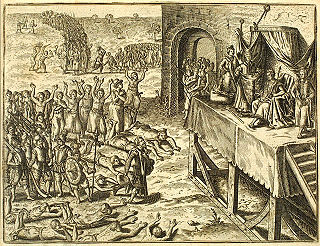
The Manikongo, or Mwene Kongo, was the title of the ruler of the Kingdom of Kongo, a kingdom that existed from the 14th to the 19th centuries and consisted of land in present-day Angola, Gabon, the Republic of the Congo and the Democratic Republic of the Congo. The manikongo's seat of power was Mbanza Kongo, now the capital of Zaire Province in Angola. The manikongo appointed governors for the provinces of the Kingdom and received tribute from neighbouring subjects.
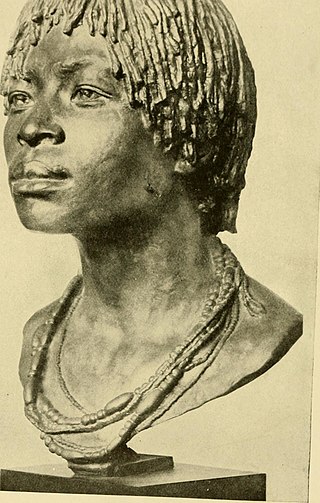
The Kongo people are a Bantu ethnic group primarily defined as the speakers of Kikongo. Subgroups include the Beembe, Bwende, Vili, Sundi, Yombe, Dondo, Lari, and others.
The Kingdom of Ndongo, 1515-1909, was an early-modern African state located in the highlands between the Lukala and Kwanza Rivers, in what is now Angola.

The Kingdom of Kongo was a kingdom in Central Africa. It was located in present-day northern Angola, the western portion of the Democratic Republic of the Congo, and the Republic of the Congo. At its greatest extent it reached from the Atlantic Ocean in the west to the Kwango River in the east, and from the Congo River in the north to the Kwanza River in the south. The kingdom consisted of several core provinces ruled by the Manikongo, the Portuguese version of the Kongo title Mwene Kongo, meaning "lord or ruler of the Kongo kingdom", but its sphere of influence extended to neighboring kingdoms, such as Ngoyo, Kakongo, Loango, Ndongo, and Matamba, the latter two located in what is Angola today.
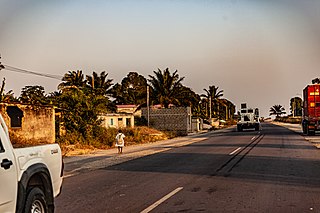
Soyo is a city, with a population of 200,920, and a municipality, with a population of 227,175, located in the province of Zaire in Angola, at the mouth of the Congo river. Soyo recently became the largest oil-producing region in the country, with an estimate of 1,200,000 barrels per day (190,000 m3/d).
The Kingdom of Matamba (1631–1744) was an African state located in what is now the Baixa de Cassange region of Malanje Province of modern-day Angola. It was a powerful kingdom that long resisted Portuguese colonisation attempts and was only integrated into Angola in the late nineteenth century.

The Catholic Church arrived in the Kingdom of Kongo shortly after the first Portuguese explorers reached its shores in 1483. Portuguese left several of their own number and kidnapped a group of Kongo including at least one nobleman, Kala ka Mfusu, taking them to Portugal where they stayed a year, learned Portuguese and were converted to Christianity. The group was returned to Kongo in 1485 and Kala ka Mfusu led a royal mission from Kongo's manikongo, Nzinga a Nkuwu to Portugal. Following their arrival in late 1486 the embassy stayed nearly four years in Lisbon with the monks of Saint John the Baptist. There they studied Christianity and Portuguese with Vicente dos Anjos, and began the start of a Kongolese version of Christianity.
Nsundi was a province of the old Kingdom of Kongo. Its capital was located on the Inkisi River, near the present-day village of Mbanza Nsundi in Democratic Republic of Congo.

The Kinlaza were members of the Nlaza kanda or House of Kinlaza, one of the ruling houses of the Kingdom of Kongo during the 17th century. It was one of the main factions during the Kongo Civil War along with the Kimpanzu and Kinkanga a Mvika kandas. They are remembered in tradition and are evoked in a proverb, still current in the 1920s Nkutama a mvila za makanda "Kinkanga, Kimpanzu ye Kinlaza makukwa matatu malambila Kongo".

Leonor Teles was queen consort of Portugal by marriage to King Ferdinand I, and regent of Portugal during the minority of her daughter in 1383-1384. She was one of the protagonists, along with her brothers and her daughter Beatrice, of the events that led to the succession crisis of 1383–1385, which culminated in the defeat of her son-in-law King John I of Castile and his armies in the Battle of Aljubarrota. Called "the Treacherous" by her subjects, who execrated her on account of her adultery and treason to her native country, she was dubbed by the historian Alexandre Herculano as "the Portuguese Lucrezia Borgia".

Mvemba a Nzinga, Nzinga Mbemba, Funsu Nzinga Mvemba or Dom Alfonso, also known as King Afonso I, was the sixth ruler of the Kingdom of Kongo from the Lukeni kanda dynasty and ruled in the first half of the 16th century. He reigned over the Kongo Empire from 1509 to late 1542 or 1543.
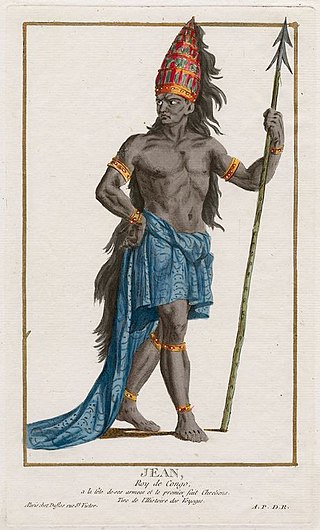
Nzinga-a-Nkuwu João I was the 5th ManiKongo of the Kingdom of Kongo between 1470 and 1509. He voluntarily converted to Roman Catholicism. He was baptized on 3 May 1491 and took the Christian name of João. Soon after, ManiKongo Nzinga-a-Nkuwu João I abandoned the new faith for a number of reasons, one of them being the Roman Catholic Church's requirement of monogamy. Politically, he could not afford to abandon polygamy and embrace monogamy, a cultural shift that the king could not contemplate as power in Kongo was elective, rather than hereditary as in Europe; as Kongo culture followed a matrilineality structure, where the elder son of the king is not automatically the next king.
The precolonial history of Angola lasted until Portugal annexed the territory as a colony in 1655.
The Kongo Civil War (1665–1709) was a war of succession between rival houses of the Kingdom of Kongo. The war waged throughout the middle of the 17th and 18th centuries pitting partisans of the House of Kinlaza against the House of Kimpanzu. Numerous other factions entered the fray claiming descent from one or both of the main parties such as the Água Rosada of Kibangu and the da Silva of Soyo. By the end of the war, Kongo's vaunted capital had been destroyed and many Bakongo were sold into the Trans-Atlantic Slave Trade.
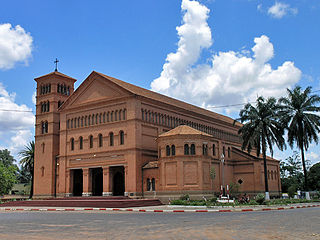
Christianity is the majority religion of the Democratic Republic of the Congo and is professed by a majority of the population.

M'banza-Kongo, is the capital of Angola's northwestern Zaire Province with a population of 148,000 in 2014. M'banza Kongo was the capital of the Kingdom of Kongo since its foundation before the arrival of the Portuguese in 1483 until the abolition of the kingdom in 1915, aside from a brief period of abandonment during civil wars in the 17th century. In 2017, M'banza Kongo was declared a UNESCO World Heritage Site.

The former Cathedral of the Holy Saviour of Congo is an old Catholic church built at the end of the 15th century in M'banza-Kongo, the capital of the Kingdom of Congo. It was the cathedral of the Diocese of Angola and Congo and one of the first Catholic cathedrals in sub-Saharan Africa and in what is now known as Angola.













